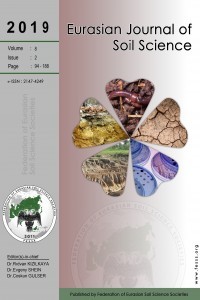
Eurasian Journal of Soil Science
Yazarlar: Henry Oppong TUFFOUR, Joseph ASARE, Gilbert Mcphelan NUTAKOR
Konular:Fen
DOI:10.18393/ejss.336816
Anahtar Kelimeler:Cumulative infiltration amount,Manometer,Saturated hydraulic conductivity,Sorptivity,Steady state infiltrability
Özet: Field and laboratory infiltration measurements using infiltrometers have been the only methods of effectively determining the infiltration rates of soils. Infiltration is mainly controlled by soil hydraulic properties, especially the hydraulic conductivity. Due to the ease with which the saturated hydraulic conductivity can be determined, it is often preferred to the unsaturated hydraulic conductivity in hydrological studies. It is well known that, at saturation the steady state infiltrability controls the infiltration process. Thus, it is very clear that the saturated hydraulic conductivity and steady state infiltrability may be closely related in one way or the other, as suggested in some few studies, wherein functions have been developed to relate these two parameters. However, these functions are often site specific and do not always carry out accurately all the time. Determination of can be tedious and time consuming, whereas can be easily determined in the laboratory. The present study aimed to assess the predictability of a modified Philip’s equation by substituting for . In this study, field infiltration measurements were conducted in two soil types under three different land use systems with a single ring infiltrometer. Field and laboratory hydraulic and hydrologic experiments were conducted on soils in a turf grass, an arable land and a pastureland in the Kwame Nkrumah University of Science and Technology, Kumasi, Ghana. Goodness-of-fit was used to compare the measured and predicted cumulative infiltration amounts from both and . The results showed that there was a robust relationship between the measured and predicted cumulative infiltration amount values from the Philip’s and modified Philip’s equations, respectively for all three fields. However, the use of in place of produced the best outcome in all the study areas. Thus, substituting for in the Philip’s infiltration equation can better predict cumulative infiltration amount. The proposed modified Philip’s infiltration equation and the key parameters (i.e., and ) provide new understanding into the realistic flow processes in soil. Furthermore, the in the new equation is very close to the measured .